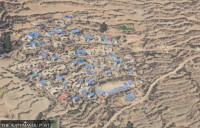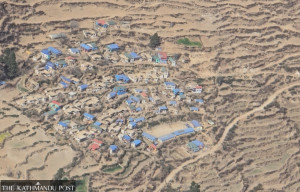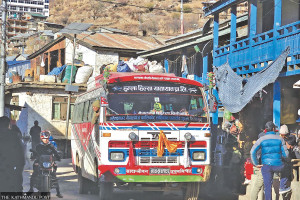Karnali Province
Around 40 percent of pregnant women undergo unsafe delivery in Jajarkot
Although the government has been running the Safe Motherhood Programme as part of its bid to ensure safe births in remote areas, only a few people are getting benefits from the programme.
Bhim Bahadur Singh
Sharmila BK, a 25-year-old pregnant woman from Kushe Rural Municipality Ward No. 7, went to Gharanga Health Post after she started suffering from labour pain. She had been in labour for two days when her condition worsened because of excessive bleeding. On January 6, due to delivery complications, the health post referred her to Jajarkot District Hospital for further treatment. Her family spent Rs 15,000 on vehicle fare to take her to the District Hospital from her village.
Jenisha Khadka, another pregnant woman from Kushe Rural Municipality Ward No. 6, was also admitted to the same health post for three days after she started labour pain. Lok Bahadur Khadka, Jenisha’s husband, said the health post referred her to the district hospital on Sunday because she had complications while delivering her baby.
“My wife could not deliver the child even in the district hospital. The hospital referred her to another hospital in Nepalgunj,” he said.
Although the government has been running the Safe Motherhood Programme as part of its bid to ensure safe births in remote areas, only a few people are getting benefits from the programme, locals claim. Many women like Sharmila and Jenisha in remote areas cannot easily get benefitted from such programmes. Their families have to spend a lot of money to save their lives, as there are no reliable health services nearby.
The majority of delivery cases with complications are being reported from Kushe and Barekot rural municipalities and Chhedagada Municipality. Locals in remote areas have no other alternative but to charter helicopters in health emergencies. Pregnant women in critical conditions have to be airlifted to city areas, as their villages are not connected by roads and medical treatment is not available locally.
Kali Bahadur Shahi, a resident of Kushe Rural Municipality, said impoverished families cannot afford to charter a helicopter for their sick members.
“Only people with connection and money can have such facilities in remote areas. Those who don’t die, as they cannot be flown out for medical treatment in time,” said Shahi.
Due to a lack of health facilities in remote areas, the majority of pregnant women tend to give birth at home. The data of the District Health Office showed that around 40 percent of women in Jajarkot still give birth at home. Health facilities in remote areas lack skilled human resources, equipment, and physical infrastructures. Tara Singh, an auxiliary nurse midwife at Gharanga Health Post, said the facility has been referring critical patients to other health facilities due to a lack of skilled human resources and infrastructures.
“In the last two months, we referred 12 patients to the district hospital,” Singh said.
Meanwhile, Narayani Shah, an auxiliary nurse midwife at Jajarkot District Hospital, said most pregnant women give birth at home due to a lack of awareness.
“The main reason for the high rate of home births in remote areas is that women do not have access to free medical services due to the remoteness of their locations,” said Shah. “Both the mother and child could be in grave danger when pregnant women do not visit health centres for prenatal checkups.”
Death during childbirth due to the lack of medical services remains one of the leading causes of women’s deaths in Nepal. According to the Ministry of Health, for every 1,000 births in Nepal, 229 women die during or after childbirth. The stats have not improved despite the availability of free services and allowances. The data also shows that only 57 percent of pregnant women seek institutional delivery. The government’s efforts to bring all pregnant women under its free health programmes to reduce and limit maternal mortality rate to 125 per 100,000 births by 2020 have remained a challenge due to factors such as a lack of proper implementation, shortage of funds and insufficient skilled human resource.




 15.76°C Kathmandu
15.76°C Kathmandu














